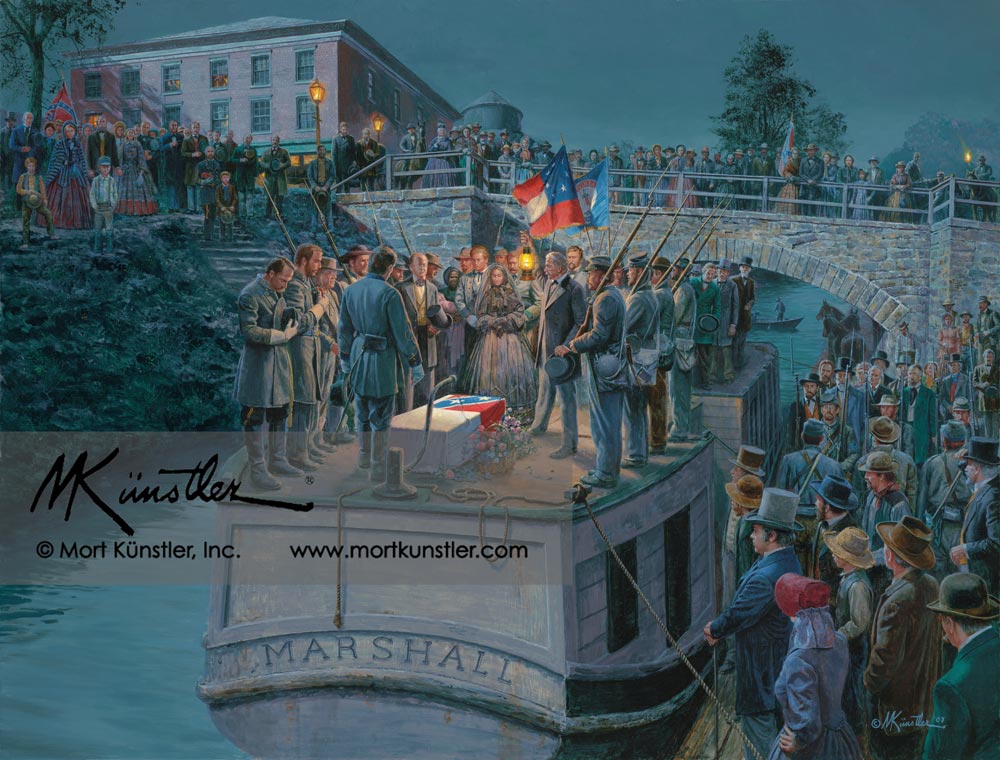Künstler
Going Home
Going Home
Couldn't load pickup availability
This is Mort Künstler limited edition print - Going Home. Stonewall Jackson Procession, Lynchburg, Va., May 13, 1863.
LIMITED EDITION PRINTS
Paper Prints
Reproduction technique: Fine offset lithography on neutral pH archival quality paper using the finest fade-resistant inks.
Each print is numbered and signed by the artist and accompanied by a Certificate of Authenticity.
Image Size: 19” x 25” • Overall Size: 24” x 29”
Signed & Numbered • Edition Size: 750
Signed Artist’s Proof • Edition Size: 100
Giclée Canvas Prints
Reproduction technique: Giclées are printed with the finest archival pigmented inks on canvas.
Each print is numbered and signed by the artist and accompanied by a Certificate of Authenticity.
Classic Edition 23” x 30”
Signed & Numbered • Edition Size: 100
Signed Artist’s Proof • Edition Size: 10
Historical Information
It was his final journey.
General Thomas J. “Stonewall” Jackson – Robert E. Lee’s irreplaceable “right arm” – was seriously wounded at the battle of Chancellorsville on May 2, 1863. Eight days later, he succumbed to a related case of pneumonia. After lying in state at the Virginia Capitol and following an official state funeral in Richmond, Jackson’s body was transported back home to Lexington, Virginia for burial.
On May 13, 1863, his funeral cortege arrived by rail in Lynchburg, Virginia. There, it proceeded through the city in a solemn procession, escorted by thousands of mourners. At the Kanawha Canal, the cortege was transferred to the packet boat Marshall. A familiar craft on the canal, the Marshall had the task of taking General Jackson up the James River on the final leg of his journey home to Lexington.
For a long and memorable pause, the Marshall waited at its mooring below Lynchburg’s Ninth Street Bridge – with Jackson’s flag-draped casket aboard and surrounded by a group of mourners. Finally, its lines were cast off, and the Marshall headed up the canal for Lexington – as a huge crowd lined the bridge to pay their respects to the fallen leader.
Stonewall Jackson was going home.
Mort Künstler’s Comments
As far as I can determine, General Stonewall Jackson’s last journey home up the Kanawha Canal has never been portrayed in art before. My close friend, Civil War historian Rod Gragg, suggested this idea to me long ago and it continued to attract me. One reason this painting is so meaningful to me is that it reconstructs a remarkable, but little-known historical event. I was also attracted by the artistic elements of this scene. You have this very extraordinary procession to honor a great fallen leader, and it’s being conducted with such typical 19th century American ceremony. Then there’s this picturesque Southern bridge that’s still around today – and is probably a little-known landmark even to many people in Lynchburg. Add to that the packet boat Marshall – whose features are well documented – and you have so many elements of a memorable painting.
Even the time of day made for good art. The procession set out up the canal about 10 o’clock that evening, and it was illuminated by torchlight and lanterns. As an artist, those facts give me a historical scene with a wonderful combination of light – the cool, soft moonlight and the warm, glowing light of lanterns. It’s an artist’s dream-come-true. So was all the wonderful cooperation I received from officials, citizens and local historians in the Lynchburg area. Jerry Shores of The Framery and Arts in Lynchburg introduced me to Sally Ann Schneider, who is executive director of the Lynchburg Historical Foundation. My good friend, Dr. James I. Robertson, Jr., the foremost authority on Stonewall Jackson, escorted me on a research trip to Lynchburg. We were assisted by an outstanding group of citizens – Mayor Joan Foster, Dennis Beeton of Dixie Outfitters, Nancy Marion of The Design Group, Colonel Keith Gibson of the V.M.I. Museum in Lexington, and Mr. O.L. Raines, who is the builder of an authentically constructed model of the packet boat Marshall. While in Lynchburg, I examined the Marshall’s preserved iron hull, and visited the site of the boat landing where the canal had been. It now is completely filled with sand and silt, but the stone Ninth Street bridge still remains. There, too, is the neighborhood’s landmark building, Amazement Square, which is a key feature in the painting.
The painting’s composition is designed to lead the viewer to the widow, Mary Anna Jackson. I used perspective, shadows and even the mooring rope to achieve this, but the most important element is the lantern light held by Lynchburg Mayor William Branch. Its warm yellow-orange light contrasts with the cool moonlight, and brings the eye inexorably to the center of interest. The bright colors of the flag and flowers also serve that same purpose. (I’m told this was the very first time the 2nd National flag was used.) The bald gentleman with the glasses is Governor John Letcher, a good friend of Stonewall’s, who accompanied the body from Richmond to Lexington. Behind Mrs. Jackson and to her right is Major Sandy Pendleton, and to her left behind the lantern is Dr. Hunter McGuire. Beside Pendleton is Mary Anna’s servant, who holds the Jackson’s six-month-old daughter, Julia.
The title of the painting – Going Home – is also very special. It comes from a traditional black spiritual of the same name.
…Going home, going home,
I’ll be going home.
See the Light! See the Sun!
I’m just going home.
Share


Continue Shopping
See more of the Breagans' collection of manufacturers from all around the world
Subscribe to our emails
Subscribe to our mailing list for insider news, product launches, and more.

